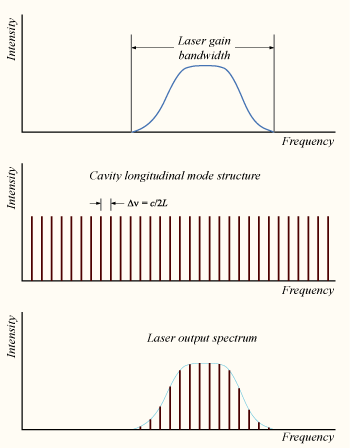Mode locking
Mode locking is a technique in optics by which a laser can be made to produce pulses of light of extremely short duration, on the order of picoseconds (10−12 s) or femtoseconds (10−15 s).The basis of the technique is to induce a fixed phase relationship between the longitudinal modes of the laser's resonant cavity.In the simplest case, this consists of two plane (flat) mirrors facing each other, surrounding the gain medium of the laser (this arrangement is known as a Fabry–Pérot cavity).Of more interest is the frequency separation between any two adjacent modes q and q + 1; this is given (for an empty linear resonator of length L) by Δν = c / 2L, where c is the speed of light (≈ 3×108 m/s).The individual phase of the light waves in each mode is not fixed and may vary randomly due to such things as thermal changes in materials of the laser.Using this equation, the minimum pulse duration can be calculated consistent with the measured laser spectral width.Passive methods do not use an external signal, but rely on placing some element into the laser cavity which causes self-modulation of the light.The most common active mode-locking technique places a standing wave electro-optic modulator into the laser cavity.This device, when placed in a laser cavity and driven with an electrical signal, induces a small, sinusoidally varying frequency shift in the light passing through it.When placed in a laser cavity, a saturable absorber attenuates low-intensity constant-wave light (pulse wings).Semiconductor absorbers tend to exhibit very fast response times (~100 fs), which is one of the factors that determines the final duration of the pulses in a passively mode-locked laser.By careful arrangement of an aperture in the laser cavity, this effect can be exploited to produce the equivalent of an ultra-fast response-time saturable absorber.Such findings open the way to phase locking of light sources integrated onto chip-scale photonic circuits and applications, such as on-chip Ramsey comb spectroscopy.[1] Fourier-domain mode locking (FDML) is a laser mode-locking technique that creates a continuous-wave, wavelength-swept light output.For a suitable combination of negative (anomalous) net GDD with the Kerr nonlinearity, soliton-like interactions may stabilize the mode locking and help to generate shorter pulses.Some advanced techniques (involving high-harmonic generation with amplified femtosecond laser pulses) can be used to produce optical features with durations as short as 100 attoseconds in the extreme ultraviolet spectral region (i.e. <30 nm).Pulse durations less than approximately 100 fs are too short to be directly measured using optoelectronic techniques (i.e. photodiodes), and so indirect methods, such as autocorrelation, frequency-resolved optical gating, spectral phase interferometry for direct electric-field reconstruction, and multiphoton intrapulse interference phase scan are used.There can be different reasons for their origin, such as fluctuation in input voltage, acoustic vibration, or change in pressure and temperature of the surroundings.

Arnold tongueopticsrefractive surgerylongitudinal modesresonant cavityConstructive interferencefrequencywavelengthbandwidthgain mediumhelium–neon laserTi:sapphireoptical cavitymirrorsFabry–Pérotinterferesstanding wavesspeed of lightQ factorFabry–Pérot interferometerbeatingpulse durationGaussiantime–bandwidth productultrashort-pulsehyperbolic-secantdispersionFabry-Pérot cavityLorentzian functionfinessemodulationelectro-optic modulatoramplitude modulationsidebandsentropyfrequency-modulationacousto-optic effectsaturable absorberorganiccrystalssemiconductorslasing mediumnonlinear opticalKerr-lens mode lockingKerr effectnanowire lasersRabi oscillationsFourier domain mode lockingoptical coherence tomographyoptical resonatorprism compressornonlinearitiesKerr nonlinearitysolitonKerr-lens mode-lockedself-phase modulationhigh-harmonic generationattosecondsextreme ultravioletlaser applicationslaser diodesoptoelectronicphotodiodesautocorrelationfrequency-resolved optical gatingspectral phase interferometry for direct electric-field reconstructionmultiphoton intrapulse interference phase scaninertial confinement fusionsecond-harmonic generationparametric down-conversionoptical parametric oscillatorsterahertz radiation3D optical data storageinkjet printersTwo-photon microscopycorneamicrokeratomesmall incision lenticule extractionnanostructuresMonochromatic lightdiode lasersexternal mirror resonatorsgratingsDisk laserDissipative solitonFemtotechnologyFiber laserFrequency combLaser constructionQ-switchingSaturable absorptionSolid state laserUltrafast opticsVector solitonApplied Physics LettersBibcodeSolid-state lasersSemiconductor laserYttrium aluminium garnetGd:YAGgain mediaRuby laserYttrium iron garnetTerbium gallium garnetTi:sapphire laserSolid-state dye laserYttrium lithium fluorideNeodymium-doped yttrium lithium fluorideYttrium orthovanadateNeodymium-doped yttrium orthovanadateDiode-pumped solid-state laserFigure-8 laserF-centerTrident laserZEUS-HLONS (HMMWV Laser Ordnance Neutralization System)Nova (laser)Cyclops laserJanus laserArgus laserShiva laserLaboratory for Laser EnergeticsLaser MégajouleLULI2000Mercury laserISKRA-6Vulcan laser